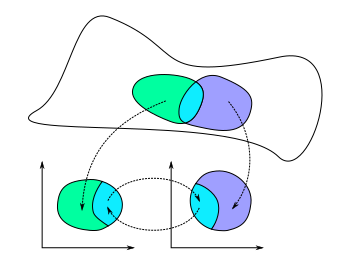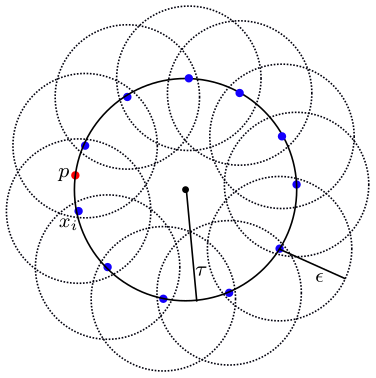Questions:
- Condition number of a manifold
- Their definition of the orientation of the faces in varies from class (no concern on parity of index)
Full paper can be found at: https://link.springer.com/article/10.1007/s00454-008-9053-2
Introduction
The class of problems known as manifold learning attempts to estimate the geometrical and topological properties of a submanifold from random points lying on said unknown manifold. The paper provides an algorithm to identify the homology of the submanifold using only random samples. The algorithm works well with noise where the points lie near the submanifold rather than on it.
Preliminaries
Let be a topological space. A chart on consists of an open set and homeomorphism such that is open. Given two overlapping charts and we construct a transition map which allows one to “smoothly” transition between charts.

We call a topological space a smooth manifold if it has a collection of charts such that each covers and for all the transition map is .
For every point on a smooth manifold, there is an associated tangent space consisting of vectors tangent to at the point . A Riemannian metric on assigns a positive-definite inner product . A smooth manifold with a Riemannian metric is called a Riemannian manifold. In summary, a Riemannian manifold is a smooth manifold with a notion of distance, angles, length and curvature.
Given a compact Riemannian manifold , we define the set
where is the distance of to . The closure of forms the medial axis and for any the local feature size is the distance of to the medial axis. We define the condition number of to be where
For example, if is a sphere of radius , then the medial axis is the sphere’s center point and .
Main Results
We wish to compute the homology of a manifold from the randomly sampled data points . To reconstruct the manifold from we construct open Euclidean balls with radius centered at each . We then define
to be the reconstructed manifold.
Proposition 3.1
Let be any finite collection of points such that for every , there exists an such that . Then for any we have that deformation retracts to . Therefore the homology of equals the homology of .
For example, consider a circle. If for every there is a point such that , then the union of balls deformation retracts to as long as .

The question then is what the probability that points sampled in an i.i.d. fashion (independent and identically distributed) satisfy the above. \
Proposition 3.2
Let be drawn by sampling in i.i.d. fashion according to the uniform probability measure on . Then with probability greater than we have that is -dense ( in provided that
where
Here is the dimension of and denotes the -dimensional volume of the standard -dimensional ball of radius . Finally, and .
Combining Propositions 3.1 and 3.2 provides a way of estimating the probability that the ball reconstruction of the manifold of i.i.d sampled points has the same homology.
Computing the Homology of
The paper outlines an algorithm for computing the homology of making use of the nerve of the cover .
- Define to be the collection of all -simplices in the nerve of , i.e., each is associated with points such that
- The size is bounded above by . However, the actual size is much smaller as two points and more than apart are not associated to a simplex. Define the simplicial complexes with face relations, then the nerve of is .
- We can compute the simplicial complex by the following decision problem: for any set of points, determine whether balls of radius around each point have non-empty intersection. It follow that if and only if the smallest radius enclosing all the points is less than .
- We define a -chain to be a function , which is written as formal sum
Adding -chains componentwise forms a vector space of -chains denoted by .
- The boundary operator is defined as follows: for each (oriented) simplex ,
where is a face of and the orientation of is given by . Thus, is then defined on -chains by additivity by
One may view as an matrix where .
- The boundary operator forms a chain complex
We define the -th homology group as the vector space quotient
where
and